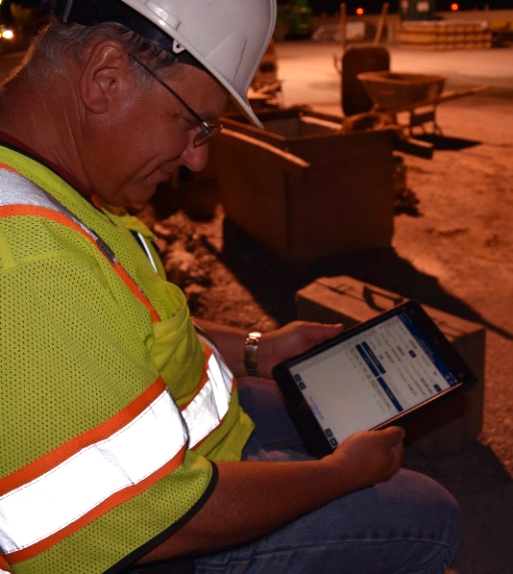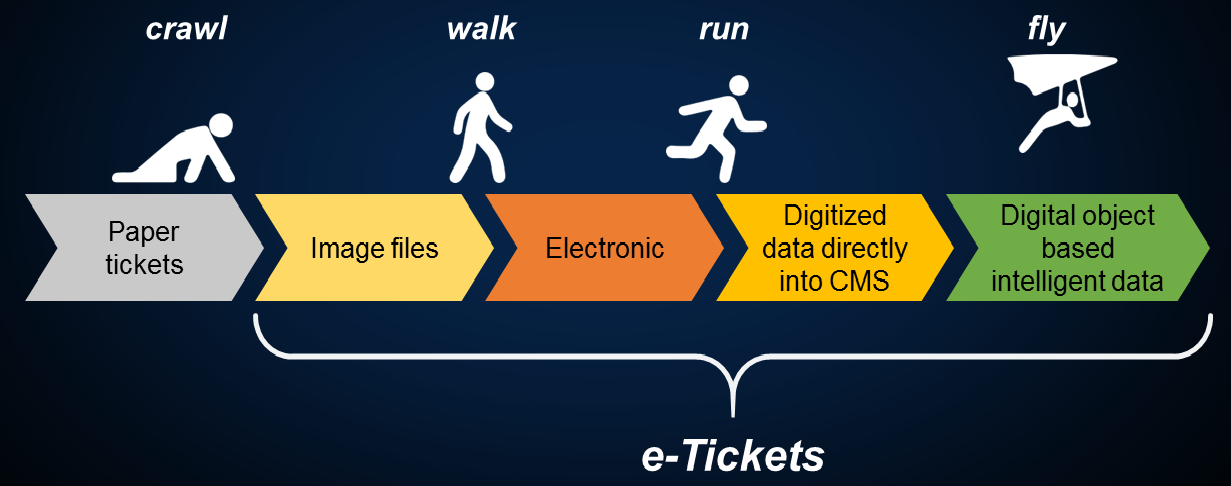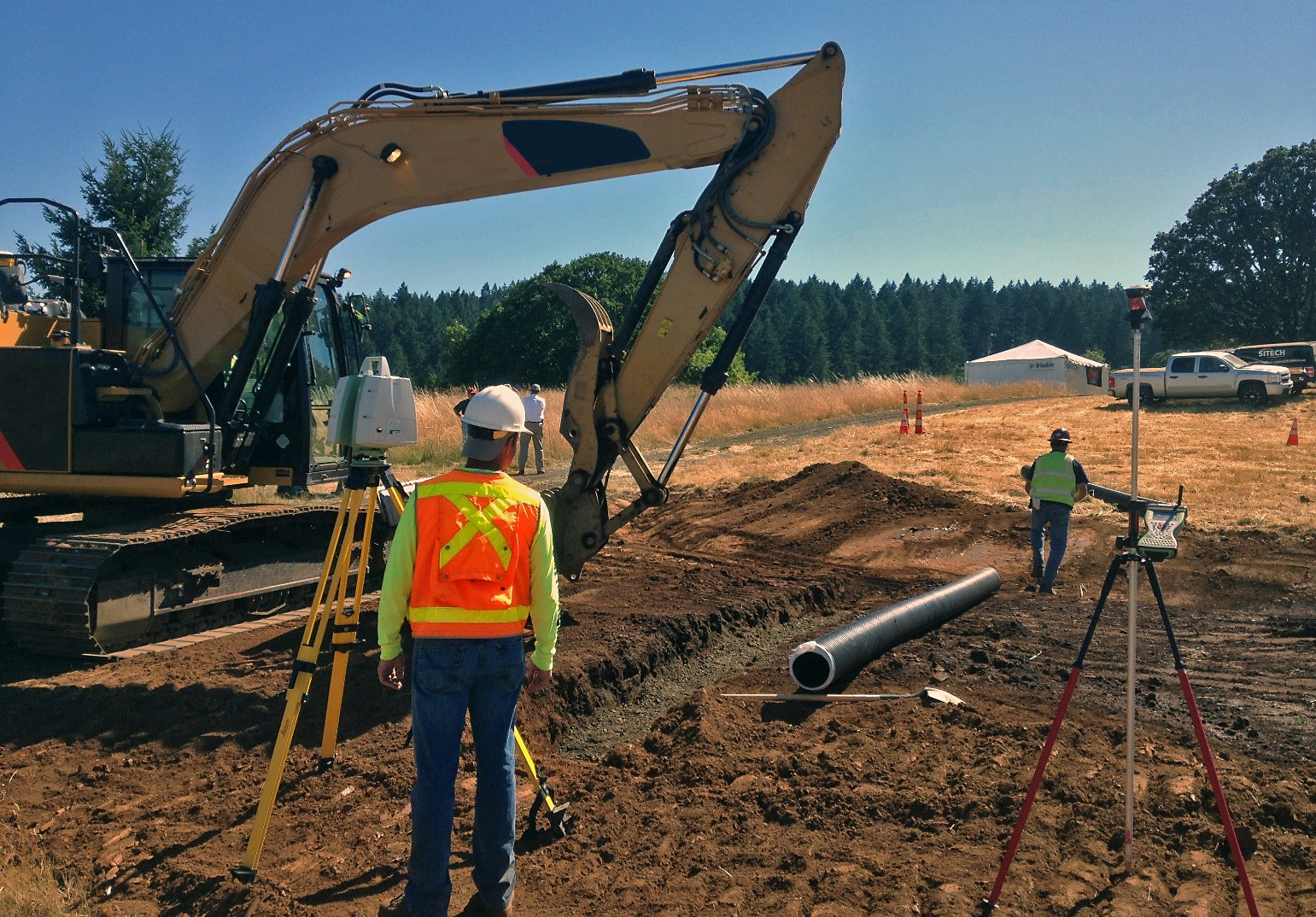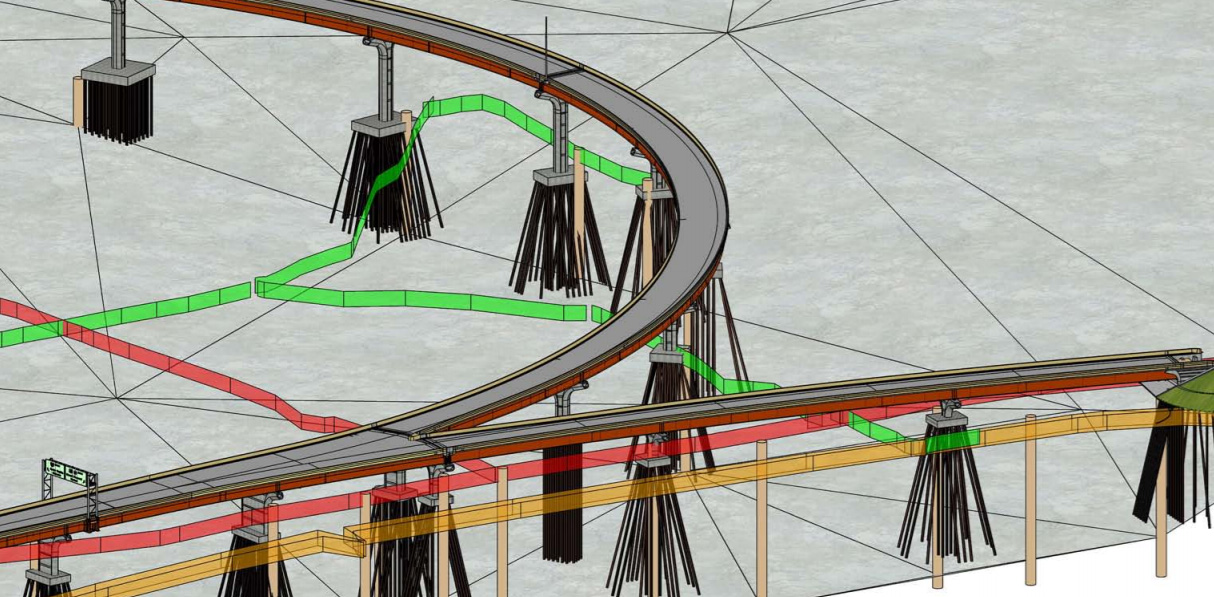
e-Ticketing and Digital As-Builts
Improving the way valuable information generated during project delivery is exchanged and utilized.
Electronic ticketing (e-Ticketing) and digital as-builts (DABs) are two innovations that make it easier for the highway construction industry to switch from paper-based exchanges to a modern, 21st century digital workflow providing information that is “smarter” and more accessible. e-Ticketing improves the tracking, exchange, and archiving of materials tickets. DABs are an accumulation of the data used during digital project delivery that provides a living record of built infrastructure for agencies’ future business needs.
Used individually, these innovations significantly enhance agency capabilities for harnessing data. Together, they increase efficiency and safety during project delivery and can result in multiple benefits when project information is readily accessible for post-construction activities, like asset management.
e-Ticketing: Streamline and Simplify
Both transportation agencies and the private sector spend considerable resources producing, sorting, recording, and archiving paper tickets. Collecting paper tickets from hauling vehicles also exposes construction inspectors and contractor personnel to safety hazards in work zones.
e-Ticketing mitigates the challenges of paper tickets through a safer, faster, less resource intensive, more sustainable and streamlined process using digital technology. e-Ticketing data can be transmitted in real time to a cloud or storage system, making it easily accessible by mobile devices for operational decisions. It creates a single source of truth that can be exchanged, via application program interfaces, directly into State department of transportation (DOT) information management systems for data mining, materials payment, or other purposes.

e-Ticketing data helps manage material deliveries, testing, and quantities as projects play out in real time.
Credit: FHWAe-Ticketing also facilitates data integration with complementary technologies, such as intelligent compaction, dielectric profiler systems, and pavement-mounted thermal profilers. This integration offers a unique opportunity to access and critically analyze quality and productivity data that is otherwise difficult to capture until after project completion.
As e-Ticketing use grows, State DOTs are discovering a need for software solutions to aggregate e-tickets from the many sources and vendors used by contractors. A number of potential solutions are available on the market, some through outside software vendors, and others through systems that DOTs developed for internal use.

Maturity of e-Ticketing technologies.
Credit: FHWAThese secure applications can help build robust audit logs and a trusted chain of custody for tickets by tracking and auditing changes during the ticket lifecycle, building confidence in ticket accuracy for both the State DOT and contractor. In some cases, they even allow contractor systems to interface with the DOT system for ticket verification.
e-Ticketing aggregation systems commonly benefit both DOTs and contractors by streamlining and simplifying materials payments. DOTs no longer have to manually keep up with all paper tickets, they simply filter the ticket database in whatever way the project managers wish then export into a spreadsheet where totals can easily be quantified. Additionally, contractors are now beginning to use data gained from e-Ticketing systems to better manage trends and quantities of materials as projects play out in real time.
Delaware Pilots e-Ticket Integration
The Delaware DOT (DelDOT) is piloting a software system, HaulHub, for integrating e-Tickets for its six hot-mix asphalt suppliers across the State. In DelDOT’s experience, suppliers often have differing systems and formats for their e-Tickets, so finding a solution that would work with all those systems and standardize the information inspectors and field staff see was important to the pilot’s success.
DelDOT’s system collects all e-Tickets from the hot-mix suppliers and assigns them to the correct project, at which point the field personnel get access to the tickets. As the pilot continues, the agency’s goal is to incorporate every hot-mix project in the State into the system.
While there has been some hesitancy moving from paper to e-Tickets, the response has been positive overall. Though the pilot is still ongoing, DelDOT already sees potential for time savings due to the auditability of tickets and other benefits, such as storage and the lessened environmental impact.
“Putting consistent, clear information at our field personnel’s fingertips is a benefit,” said Billy Sweeney, DelDOT’s project controls coordinator. “Another extremely important factor is the increased safety of our people.”
Looking forward, DelDOT’s goal is to integrate e-Ticketing with other e-Construction databases and potentially use the captured metadata from the e-Tickets to help measure paving performance or possibly identify problems for sites using business intelligence software. “Using the data that these systems collect in an intelligent way is what we see as the ultimate goal,” said Sweeney.
Utah’s Homegrown Solution
The Utah DOT (UDOT) is using FME, an ArcGIS® database, and an ArcGIS®-based solution called Survey123 that has allowed e-Ticketing integration in-house without needing external software or vendors. When UDOT began e-Ticketing, the State already had a license for ArcGIS® and personnel who knew how to use it, which created an easier learning curve for using this type of solution.
In addition to having all tickets route through a single system, UDOT notes this application is easy to use for inspectors and can be installed on any device. When tickets are accepted in the field by inspectors, the ticket plus any notes go into the ticket database. UDOT is also developing a contractor’s access site through the application, which will allow them to see the tickets in real time. Using the same database in this way has provided a benefit to both UDOT and contractors for troubleshooting missing or incorrect tickets.
“The overall efficiencies provided by the system and by having real-time data give greater command to how you manage a project, both from a DOT and a contractor perspective,” said Ken Talbot, UDOT State construction engineer for quality management. “Our inspectors and contractors are already seeing benefits from using the app.”
Digital As-Builts: “Collect Data Once, Use It Often”
Traditional as-built drawings record field changes on paper plan sheets or PDFs and do not capture much of the additional valuable information generated during design and construction. Current as-built approaches are largely paper-based and resource intensive and make agency-wide, long-term management of the data ineffective. This means important information is often difficult to access later and is sometimes incomplete.
For example, current as-builts do not include accurate feature locations or a complete record of an asset’s condition information generated during design and construction, such as underground utilities placements, materials specifications, and quality assurance data. This valuable data is often lost, requiring re-collection throughout the asset’s lifecycle and costing agencies considerable resources, not to mention opportunity losses when data is not readily available for analysis and decision-making.

Geolocated information, particularly for utilities and foundations, can best be captured during construction and passed into the next phase of the project life cycle.
Credit: FHWADABs, however, are created with digital data already collected as the project is designed and built—providing a sustainable and searchable record. Drawn from digital project delivery practices such as 3D models, e-Construction, and unmanned aerial systems, DABs are evolving to incorporate many types of asset data records with their GPS location information. Example data include design models, right-of-way locations, pavement and structures attributes, quality assurance (including data from e-Ticketing), and subsurface utilities.
Data can be contributed by various partners in the project delivery process and validated and managed by the agency as part of its enterprise data management system. Industry is moving from using the term “as-builts” to “project information model” (PIM) to capture the idea that there is more valuable data than just the plans. This PIM will contribute to a lifecycle “asset information model (AIM).” In addition to 3D design models, PIMs and AIMS are collections of data organized for an agency’s business needs.
The benefits of DABs begin with sharing the digital information as design and construction progresses, enabling better communication and virtual collaboration both before and when the project goes to the field. DABs further leverage this valuable information by incorporating the updated geometric design (advanced PDF or preferably 3D design model) with other important construction data to reflect the project’s as-built condition for future maintenance, asset management, and next cycle project scoping.
A data-rich as-built, or project information model, will contribute to a geospatially accurate “digital twin,” or asset information model, of an agency’s transportation system. The readily accessible and integrated data becomes a valuable asset as it provides agencies with comprehensive information on their asset inventory.
Watch this UDOT video to learn more about the agency’s approach to digital delivery.
Credit: Utah Dept. of TransportationUtah Pursues a Digital Twin
The Utah DOT (UDOT) recently received an Accelerated Innovation Deployment (AID) Demonstration grant from FHWA to advance digital construction with data capture. The focus is on identifying the data from construction that is relevant to the work of various UDOT disciplines and developing a process to capture that data into systems that support widespread use and regular updates.
This effort is a step along the way to UDOT’s goal of having a digital twin of its assets. UDOT’s vision is that agency staff will use digital twins to access a reliable record of an asset’s history and current status to support decision-making. The agency created a Digital Twin Strategic Plan with details on how it sees this strategy evolving.
“What we have today is a comprehensive asset data set that is basically static, with updated information collected every other year,” said Becky Hjelm, UDOT digital delivery/digital twin advancement manager. “We want to move from that to something that is a comprehensive, living data source. So if there’s a construction change, it’s accessible for users of that data.”
Hjelm said the agency expects to see big benefits in terms of the time it takes to gather information for analysis and the resources expended to collect project data, including data captured from sources such as e-Ticketing. “Marrying information on field conditions at the start of and during construction with the data we collect on material samples could help implement projects in the best possible way,” she said.
Iowa Pilots BIM for Bridges

Iowa DOT’s BIM enabled interdisciplinary coordination between geotechnical, roadway, drainage, utilities, lighting, and mechanical on this bridge project. The model would be updated and other asset data added to make it a digital as-built.
Used with permission ©Iowa Department of TransportationIn a recent pilot project, the Iowa DOT successfully delivered a three-span, curved, steel-plate girder bridge construction project using a Building Information Model (BIM) as the legal bid document. The agency next plans to update the model to the as-built condition so it can be used for asset management.
Ahmad Abu-Hawash, chief structural engineer at Iowa DOT, said the agency’s vision is to create a digital twin in the form of a BIM model that can house all information related to an asset, from design specifications to material reports to data from inspections, structural health monitoring, nondestructive evaluation, and more.
He said that by implementing DABs, Iowa DOT expects to eventually decrease the cost of project development, delivery, and asset management due to increased design and construction quality, fewer change orders, better understanding of the design intent, and efficient access to data. The increased efficiency is expected to help overcome budget constraints and an anticipated shortage in qualified workforce.
Iowa DOT is beginning the process of developing a formal road map and strategic plan that will identify the potential tools for saving, storing, and accessing data from the as-built digital model. The agency envisions that BIM model development will start in design then be confirmed and updated during construction. Maintenance staff will then update the model at every inspection cycle so asset managers can make the appropriate decisions based on current data.
For other transportation agencies embarking on the journey to DABs, Abu-Hawash suggested they reach out to other State DOTs for advice and start with a road map. “The first application is a learning process,” he said. “It’s not very realistic to expect efficiencies right away; it’s an investment in the future.”
—MORE INFORMATION
Contact Kathryn Weisner (e-Ticketing) or David Unkefer (digital as-builts) of the FHWA Resource Center.
Visit the EDC-6 e-Ticketing and digital as-builts web page for links to additional resources.
Notice:The U.S. Government does not endorse products or manufacturers. Trademarks or vendor/manufacturers’ names appear in this document only because they are considered essential to the objective of the document.
Recommended Citation: U.S. Department of Transportation, Federal Highway Administration - Washington, DC (2021) Innovator Newsletter, September/October 2021, Volume 15(86). https://doi.org/10.21949/1521364



